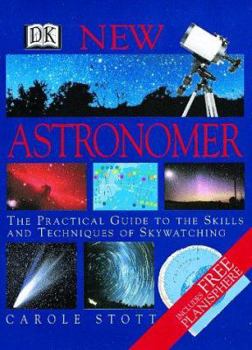New Astronomer
For thousands of years, observers have gazed up at the night sky and wondered at the celestial bodies that occupy the vastness of space. If you have ever wanted to learn more about such phenomena, or... This description may be from another edition of this product.
Format:Hardcover
Language:English
ISBN:0789441756
ISBN13:9780789441751
Release Date:September 1999
Publisher:DK Publishing (Dorling Kindersley)
Length:144 Pages
Weight:2.00 lbs.
Dimensions:0.7" x 8.8" x 11.2"
Customer Reviews
4 ratings
Stars & More
Published by Thriftbooks.com User , 15 years ago
This was a great book for me to start my quest of the stars and planets with my new telescope. It is easy to read, has loads of pictures, and gave me more than enough information to have fun and learn about our physical universe. I don't remember who recommended it as a starting point for me but the recommendation was right on. It's now part of my library and I refer to it on a regular basis when I am "star-gazing".
Up, up and away!
Published by Thriftbooks.com User , 20 years ago
Carole Stott's 'New Astronomer: The Practical Guide to the Skills and Techniques of Skywatching' is a wonderful and useful guide for actually getting into the experience of astronomy. Astronomy is one of the most egalitarian of sciences; true, the mathematical constructs of theoretical cosmology and particle physics etc. are beyond the ability of most to perform (who has the education, or the cyclotrons, to do such?). But each of us can walk into the back yard (or, if in a city, drive out to the countryside) and stand in awe and wonder at the sky above, and then begin our own searches, for comets, meteors, and other phenomena.Astronomy remains one of the few sciences left where the average person with average ability can still make a wondrous contribution. Astronomy in fact depends upon the amateur ranks scouring the skies, for there aren't enough professionals and hours of darkness for it to be held in professional exclusivity. This book can help get you started. It is a good, basic primer of what to do as a backyard astronomer and develop some respectable skills at it. But this book isn't only for beginners-I use this book as a reference for techniques and equipment, and as a guide for observation.The first part of the book covers basic ideas about the sky, and how and what to observe, introducing the idea of star movement and sky maps, so that coordinates make sense. Then it gets into the nitty-gritty (just 20 picture-filled pages into the book) of what you need to begin. From compass and planisphere (included with the book) to dressing appropriately for comfort and making a make-shift, star-viewing-friendly torch (flashlight), this book covers the bases. It introduces how the observational distances are discussed (finger width, hand width, angles, etc.), and gives the merits and proper of use of binoculars, telescopes, photographic equipment, and digital/computerised equipment. Then, you're off!Finding and viewing the planets are the first task. Scale and distance are discussed, as are motion and location. There is a handy chart for each planet that shows position relative to a starry backdrop for dates through to the year 2010. Relatively closer planets, such as Mercury, can be difficult to discern due to the sun's overpowering brilliance (the discussion of transit of Mercury and Venus is interesting). Discussion of phases (for Venus especially), satellites and moons, rings and colours all adds to the observational experience.Next up-the Moon. Our closest neighbour in space, it is fascinating to experience anew by close observation with even low-powered binoculars. Here you will find out why the full moon is not the best time to view (contrary to what one might thing), and become acquainted with the various features of the moon, and which features are best observed during which phase of the moon. Lunar eclipses are explained. Of course, we never see from the earth more than one side of the moon, but because of the moon's wobble, we do in fa
An excellent read.
Published by Thriftbooks.com User , 22 years ago
This beginners book for amateurs has information in it you simply won't find in most other astronomy books (ie: a complete list of all the constellations). A great reference volume and a fine addition to most libraries. Don't miss.
An excellent astronomy beginners book
Published by Thriftbooks.com User , 23 years ago
This book is fantastic for those who either just bought their first telescope or just want to learn more about the stars by looking through binoculars. I am 37 years old and it did not seem too elementary for me. This book will gently guide you through the heavens in a way that doesn't insult your intelligence. It shows you in a simple way how to find planets and teaches you how to read star charts, all while giving you a basic education in astronomy. Great book!




